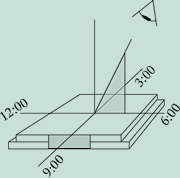VIEWING ANGLE Viewing angle is the direction from which the display will look the best. It is set during the manufacturing process, and cannot be changed later by rotating the polarizers. Viewing direction is specified as positions of a clock face, see figure above. A twelve o'clock viewing angle means that the optimum direction is above the normal to the display, while a part with a six o'clock viewing angle is best viewed from below the normal.
In a direct drive display, viewing angle is not critical because the display will look good from almost any direction. It becomes critical when the display is multiplexed, the higher the multiplex rate, the greater the problem. In displays with extremely high multiplex rates, great care must be taken when designing the drive circuitry. Special films can also be applied to the front of the display glass to enhance the overall view ability, however they tend to be expensive. Contact our Engineering Department for help in designing your circuits.
|
|
| Glossary | LCD Module | LCD Panel | Backlight | IC | Top |
 When
specifying the viewing direction, one needs to think about how the
device is going to be used. For example, a calculator is usually
sitting on a desktop or held in the palm of your hand and viewed
from the six o'clock direction . Some instrumentation, like a wall
thermostat, may be mounted below the viewer and needs to be viewed
from the twelve o'clock direction. Other viewing angles are possible
but not common. A car clock display, which will always be to the
drivers right, may have a nine o'clock viewing angle, or possibly
a ten-thirty one if the clock is low on the dashboard.
When
specifying the viewing direction, one needs to think about how the
device is going to be used. For example, a calculator is usually
sitting on a desktop or held in the palm of your hand and viewed
from the six o'clock direction . Some instrumentation, like a wall
thermostat, may be mounted below the viewer and needs to be viewed
from the twelve o'clock direction. Other viewing angles are possible
but not common. A car clock display, which will always be to the
drivers right, may have a nine o'clock viewing angle, or possibly
a ten-thirty one if the clock is low on the dashboard.